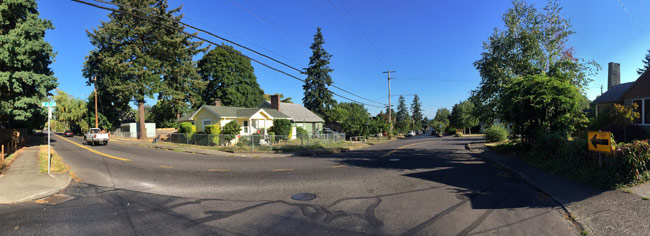By Doug Decker

Prescott Street jogs at its intersections with 37th and 33rd avenues for reasons steeped in time, technology and development strategies.
The Question: Why does Prescott Street jog between 33rd and 37th avenues? There must be a reason. – Dave Lynch, 35th Place
The Historian Reports: In this case there is no one single reason. There are multiple reasons related to changes in surveying proficiency, the passage of time, the helter-skelter nature of development and developers operating at the edge of the city limits in1900, and a complete absence of planning in our turn-of-the-last-century city.
Let’s look at the basic ingredients.
The grid
Back in 1850, surveyors used a grid to map Oregon and to organize our landscape into big boxes and small boxes, known as townships, ranges and sections. In Northeast Portland, our main east-west streets are organized on section or half-section lines. Prescott – all but the four-block stretch we’re talking about here – rests on a half section line.
The plats
Portland has more than 900 of these, basically plans that divide the land into lots and streets. Developers were in charge of their own plats, and they gave them unique names – some of which are pretty interesting, but that’s a subject for a future column. A plat called Willamette Addition, drawn and filed in 1888, contains the area from Skidmore to Killingsworth streets and from 33rd to 37th avenues. Of particular note, running along the bottom of that plat, is our mystery stretch of Prescott between 33rd and 37th.
So here’s what happened
The Willamette Addition was anchored on the south boundary to what in 1888 was thought to be the half-section line, the future Prescott. Actual development of the Willamette Addition didn’t happen until the 1920s and, inmany cases, much later.
Both Alameda Park (the neighboring plat to the west) and Wilshire (the neighboring plat to the east) were laid out in 1909 and 1921 respectively, by different developers using different survey technology. And guess what? The location of the real Prescott (in alignment with the more-recently-surveyed half-section line) moved about 75 feet to the north.
Meanwhile, the Willamette Addition was still just a drawing and the raw land was owned by different developers. Its four-block southern boundary, referred to as Columbia Street, was stuck on the grid of 1888 and quickly became irrelevant.
The developers of Alameda and Wilshire weren’t in control of the Willamette Addition, but they had to build streets around it and needed to tie their new neighborhoods into the actual half-section-line-based street we knowtoday as Prescott. So, build they did, marooning this yet-to-be developed four-block stretch of what they called Columbia Street 75 feet to the south, and necessitating eventual construction of the s-curves we know today when development of the Willamette Addition finally followed years later.
Thanks for asking!
Have a question for the neighborhood historian? We love solving mysteries. So, if you have a question for the neighborhood historian, email it to CNewsEditor@ConcordiaPDX.com and we’ll ask Doug Decker to do some digging.